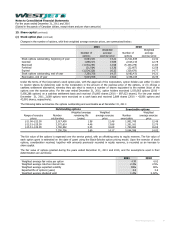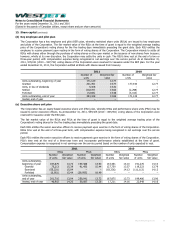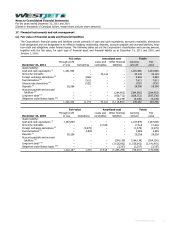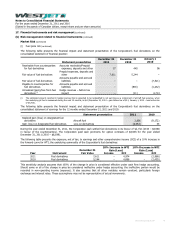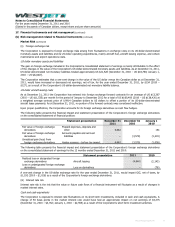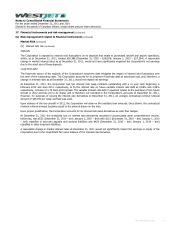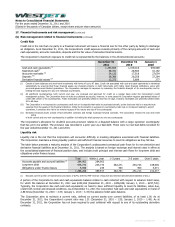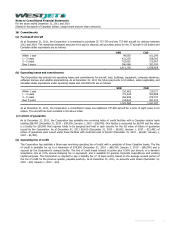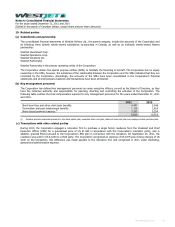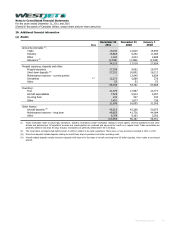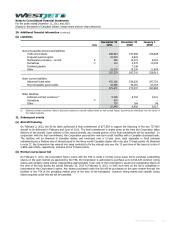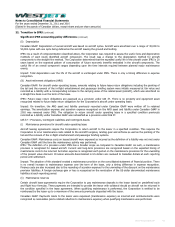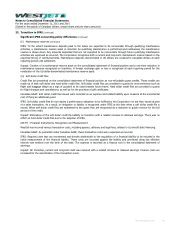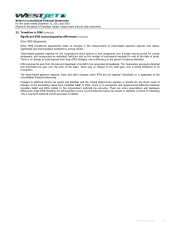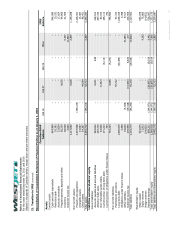Westjet 2011 Annual Report Download - page 97
Download and view the complete annual report
Please find page 97 of the 2011 Westjet annual report below. You can navigate through the pages in the report by either clicking on the pages listed below, or by using the keyword search tool below to find specific information within the annual report.
Notes to Consolidated Financial Statements
For the years ended December 31, 2011 and 2010
(Stated in thousands of Canadian dollars, except share and per share amounts)
│
17. Financial instruments and risk management (continued)
(b) Risk management related to financial instruments (continued)
Market Risk (continued)
(iii) Interest rate risk (continued)
Deposits
The Corporation is exposed to interest rate fluctuations on its deposits that relate to purchased aircraft and airport operations,
which, as at December 31, 2011, totaled $28,386 (December 31, 2010 – $28,258; January 1, 2010 – $27,264). A reasonable
change in market interest rates as at December 31, 2011, would not have significantly impacted the Corporation’s net earnings
due to the small size of these deposits.
Long-term debt
The fixed-rate nature of the majority of the Corporation’s long-term debt mitigates the impact of interest rate fluctuations over
the term of the outstanding debt. The Corporation accounts for its long-term fixed-rate debt at amortized cost, and, therefore, a
change in interest rates as at December 31, 2011, would not impact net earnings.
At December 31, 2011, the Corporation had two interest rate swap contracts outstanding with a 12 year term beginning in
February 2012 and June 2012, respectively, to fix the interest rate on future variable interest rate debt at 2.89% and 2.99%
respectively, inclusive of a 75 basis point spread. The variable interest rate debt in question relates to the purchase of two future
aircraft in 2012 and has yet to be drawn and is therefore not recorded in the Corporation’s accounts at December 31, 2011.
However, for purposes of valuing the interest rate derivatives at December 31, 2011, an average contractual nominal notional
amount of $35,000 per swap contract was used.
Upon delivery of the two aircraft in 2012, the Corporation will draw on the available loan amounts. Once drawn, the contractual
nominal notional amount becomes equal to the amount drawn on the loan.
Upon proper qualification, the Corporation accounts for its interest rate swap derivatives as cash flow hedges.
At December 31, 2011 the unrealized loss on interest rate derivatives recorded in accumulated other comprehensive income,
before tax, was $532 (December 31, 2010 – $nil; January 1, 2010 – $nil) with $112 (December 31, 2010 – $nil; January 1, 2010
– $nil) classified in accounts payable and accrued liabilities and $420 (December 31, 2010 – $nil; January 1, 2010 – $nil)
classified in other long-term liabilities.
A reasonable change in market interest rates at December 31, 2011 would not significantly impact the earnings or equity of the
Corporation due to the insignificant fair value balance of the interest rate derivative.
WestJet Annual Report 2011 97


